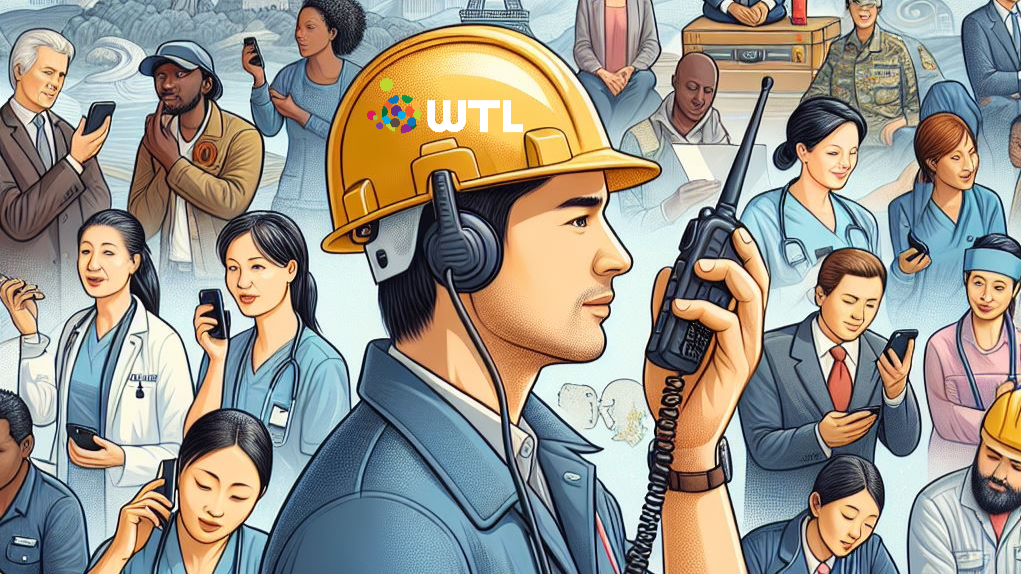WTL Push-To-Talk over Cellular
- This presentation introduces WTL Push-To-Talk over Cellular (WTLPTToC).
- WTLPTToC is a modern communication solution that utilizes cellular networks for instant and efficient communication.
- This technology is evolving beyond traditional walkie-talkies.
Push-to-Talk over Cellular
Push-to-Talk over Cellular (PTToC) is a technology that allows users to communicate instantly by pressing a button on their phone screen, like traditional walkie-talkies, but over cellular networks. Group calls can be made without dialing or waiting for a connection, as the connection is instantaneous.
PTToC takes advantage of the broad reach of cellular networks, offering a cost-effective and scalable solution for vital communications.
Traditinal Push-to-Talk challenges
Traditional walkie-talkies face limitations such as:
- Restricted range
- Hight frequency licensing costs.
- Potential interference, and weak signals, especially in areas with poor coverage.
- A privacy concerns may arise in densely populated areas


- Real -time location tracking
- Emergency Alerts
- Multimedia sharing
- Improved voice communication
- Voice recording and retransmission
All of these in one device
Benefits of WTL PTToC

- Enhanced user experience
- Low ownership costs since no dedicated hardware is needed for onboarding
- Increased safety for remote workers
- Improved workforce management enhances efficiency and boosts productivity
- Global coverage, not restricted by geographical locations.
- PTToC provides worldwide connectivity, unlike two-way radios which operate within a limited range.
Who Uses Push To Talk over Cellular (PTToC)?
Field Workforce
Businesses with field workforce stay connected with the headquarters and several other teams daily to ensure a smooth workflow.
Employees
Employees working in construction and mining sites have a constant threat to their lives and every communication is critical. They need to leverage simple and fast communication with their managers and team members.
Driver
Fleet drivers and delivery riders in logistics and Transportation sectors work for long hours to ensure timely delivery of their shipments. They need to always keep in touch with their clients and supervisors.
Production units
Production units, manufacturing lines in manufacturing and warehousing as well as warehouse operations are labor intensive. Push to talk enhances communication without interfering with work processes. The calls just come, and all the workers do is just listen to messages and to take necessary action.
Retail and hospitality industry
Retail and hospitality industry needs PTToC even more. Employees working in these sectors communicate daily with their crew members and clients on a daily bases in very quick and discrete manner, which is enabled by the PTT technology.
Security agents
Security agents, police officers, firefighters, etc. communicate using walkie-talkie push to talk radios. For time-critical environments It becomes even more efficient with PTToC.

With the global growth of the e-commerce sector, millions of businesses and delivery personnel are likely to adopt PTT for enhanced communication.

Security Services
Due to importance of security in everyday life, there is likely to be a high demand for efficient communication tools in the private and public security sector.

Agriculture
Since a significant portion of the workforce is employed in agriculture, this sector could represent a substantial user base for PTT in rural areas.

Construction and Field Services
The rapidly growing construction sector presents another major opportunity for PTT adoption
Further breakdown of target applications
- Transportation and Logistics
- Distribution Services
- Trucking Companies
- Rent and leasing Car Agencies
- Bus and Shuttle Services
- Warehousing and Supply Chain
- Large Businesses
- Utilities
- Cable and Telecommunications
- Food Services
- Waste Collection
- Security Companies

Market Projections for Push to Talk over Cellular (PTToC)
The Push-to-Talk over Cellular (PTToC) market in Africa and the world at large is set to experience substantial growth. Mobile Virtual Network Operators (MVNOs) will use wireless capacity from Mobile Network Operators, while leveraging PTToC amongst other Valued Added Services to offer enhanced communication services to their customers.
In Africa, the growth of Mobile Network coverage and the demand for inexpensive and affordable communication solutions are key drivers behind the increasing adoption of PTToC.
This growth is fueled by the rising demand for efficient communication across various sectors, including Logistics and Delivery Services, Security Services, Agriculture, Construction, Hospitality, Utilities and Field Services.
As the telecommunications landscape evolves, Mobile Virtual Network Operators (MVNOs) will look at ways of broadening subscriber base by investing in substantial business prospect outside of traditional voice and data services. MVNOs will broaden their service offerings by tapping into new market segments such as PTToC to enhance their revenue streams.
While the revenue projection for PTToC in Africa is not be readily calculated, the projection of revenue for Nigeria can be estimated with telecom sector data available.
Global Outlook?

Industry research by GlobeNewswire shows that the global Push-to-Talk Over Cellular (PTToC) market size is projected to reach US$ 8031.4 million by 2027, from US$ 3204 million in 2020, at a CAGR of 14.0% during 2021-2027.

The global Push-To-Talk (PTT) market size was valued at USD 27.04 Billion in 2020 and is expected to expand at a Compound Annual Growth Rate (CAGR) of 9.3% during the forecast period 2023 - 2032, reaching a Revenue forecast of USD 78.54 Billion by 2032.



